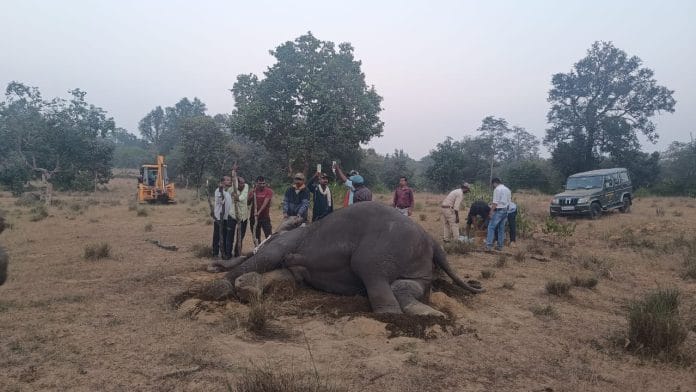Bhopal: Hours after four wild elephants were found dead in Madhya Pradesh’s Bandhavgarh Tiger Reserve, another three who were in critical condition succumbed late Tuesday. Two more elephants are undergoing treatment.
A senior forest officer said the elephants are believed to have consumed millet crops that had gathered fungus as villagers had stacked them near the fields after harvesting for several days. The post-mortem report is however awaited.
ThePrint earlier reported that on Tuesday afternoon, the patrolling staff had found four dead elephants in the core Khitauli zone in the national park, which triggered a frenzied search for the rest of the herd. The forest guard soon found another five elephants slumped on the ground and terribly unwell.
Even though veterinarians were rushed from the Sanjay Dubri park, along with a team of the School of Wildlife Forensic and Health in Jabalpur, three of the pachyderms died. The other two are still in a critical condition.
How did they fall ill?
The reserve’s deputy director Prakash Verma said the seven dead elephants were from a herd of 13 found usually in the tri-junction area of Khitauli, Pator and the Panpada buffer area. The area has villages nearby.
The herd was reported moving Monday night from Bagaiya, Badwai towards Salkhaniya. The elephants were shooed away by Salkaniya residents, a senior forest officer told ThePrint.
The officer said there were stacks of harvested kodo and kutki millet crops that the villagers had stored near the fields. “The crops were a few days old and are known to get fungus. It is believed the elephants ate the millets with fungus… this could have been a probable cause of their death. There were no marks found on the animals’ bodies.”
Forest officers said elephants have no tolerance for kodo and kutki, while these millets are staple food for the tribals in that region.
Principal Chief Conservator of Forests (PCCF-Wildlife) Vijay N. Ambade told ThePrint: “The death toll has increased to seven, and we are keeping a close eye on the others as well. The post-mortem of the first elephant has just begun and the preliminary cause can only be established after the report comes in.”
Forest officers said that if proven, this would not be the first instance of elephant poisoning in the region from kodo and kutki millet. In 2022, an elephant had died under similar circumstances in the Bandhavgarh Tiger Reserve.
Several human-animal conflict mitigation measures yet to take off
Bandhavgarh did not have an elephant population until 2018 when a herd of some 13 Asiatic elephants came from Chhattisgarh and settled in the park, which has abundant food and water for jumbos.
But as their population increased over the years — there are roughly around 50 now — more and more human-animal conflicts were reported. In some cases, this triggered forest fires as villagers tried to chase them away with lit torches.
Speaking to ThePrint, wildlife expert Abhilash Khandekar said, “A major fire was reported in Bandhavgarh in 2021 as small farmers tried to shoo elephants away.”
Khandekar was a member of the Wildlife Board of Madhya Pradesh in 2021 and then a part of the expert committee headed by Raman Sukumar, an Indian ecologist and expert on Asiatic Elephants.
He said to avoid human-elephant conflict and injuries to the pachyderms, a slew of measures were suggested to the government, including putting up electric wires with alternating current as has been implemented in other states. “But I don’t think most of them were implemented,” he said.
In the meanwhile, elephants from Chhattisgarh began to stay longer in Madhya Pradesh and this resulted in more attacks on villagers and cattle, and crop raiding.
The state government then prepared an “elephant manual” with a set of standard operating procedures for the forest staff to handle such situations. It laid out compensation for the damaged crops and cattle, and also suggested proactive measures to restrict elephant movement to specific areas by training farmers in bee farming. But most of these have remained on paper.
(Edited by Tikli Basu)
Also Read: Four wild elephants found dead in MP’s Bandhavgarh Tigre Reserve






